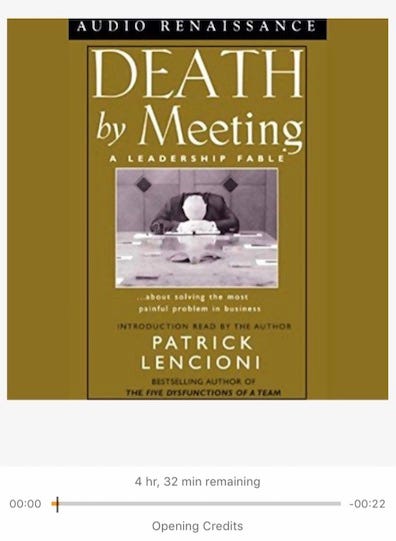Death by Meeting by Patrick Lencioni

People dread meetings, people dislike meetings, and other people don’t look forward to meetings. It’s rare to find people excited about going to meetings. I thought that this book might be repetitive and share a lot of things that I already knew. I was wrong. There were many many things that this book taught me. The way that this book was written was incredible, it was a story and something that was very relatable.
I loved this important note. If we ask people to change something without them first looking at us as credible or trustworthy, chances are they’ll say no.
“Because of the credibility he had established with the team over the past two weeks, they agreed.” Message: generate credibility BEFORE making requests
This is a difficult position and I liked the awareness that the author placed within his main character of Will. Sometimes when people are already preparing themselves for a certain outcome it is important to respect that rather than trying to change the way they are thinking and force them to change their actions.
Will wanted to object but realized Casey was already preparing himself for the worst.
I don’t believe many people do this but it definitely is important to understand what others are thinking and to truly show freedom to express other viewpoints. I know most people do not always feel able to show differing points of view.
Pause after stating something to give people a chance to disagree.
I was not a fan of this until I understood the underlying reason. It’s important to view things from a different perspective and broaden our horizons. Often, if we are in the same environment the entire time, we do not realize the difference between the colors gray and black. When I do have my own company in the future with many employees, this will definitely be a very very important thing.

Quarterly offsite reviews provide an opportunity to step away from the daily, weekly, and monthly grind and review things from a distance.
Can review strategy, the competitive landscape, moral, the dynamics of the executive team, top performers, bottom performers, customer satisfaction, pretty much everything that has a long term impact on the success of the company
Another thing I think that people should do more often. Just because we know that something is right does not mean that we need to voice that at all times. There is a difference between needing to be right and executing regardless of whether others know we are right. As the saying goes, “Work hard in silence, let your actions speak for themselves.”
Will wanted to voice his opinion but restrained because he didn’t want to insult his boss’s intelligence.
Most meetings have the same issues. People could probably find the same problems with most meetings — they are boring and ineffective. If our people are both bored and ineffective… how can we expect any growth in the company?
2 general problems with meetings:
1. They’re boring
2. They’re ineffective
Boring because they lack drama and conflict Ineffective because they lack contextual structure.
I love this idea. We want to show why people need to be at meetings and not only that but why they need to be present within meetings also. By generating interest, engagement overall should be able to be increased.
Beginning a meeting with “the hook”
Illustrate the dangers of a bad decision.
Highlight a looming competitive threat.
Appeal to participants’ commitment to the larger mission of the organization and its impact on clients, employees, or society at large.
Many people do not like conflict and many others are simply uncomfortable experiencing it, especially in situations where they are not used to experiencing it — like the office. It’s imperative that we remind people that what they are doing is OK. I’m the type of person who does not need that type of reassurance, you give me your word and I expect that’s how it will be until it changes. Most people though need some reassurance and affirmation over the course of beginning a new normal.
When participants experience conflict, it’s valuable to stop and ask permission, to remind participants that the conflict is good, and supposed to happen.
Of the 4 basic types of meetings, I think that most people do not successfully do the second, weekly tactical meetings. These are essential as they are centered around projects, go over specific things, and capitalize on the momentum that is being built within the company.
4 basic types of meetings:
1. The daily check-in, 5 minutes standing up with executives, maximum 10 minutes
2. Weekly tactical, 45–90 mins, lightning round where everyone reports their 2 or 3 priorities for the week — only 60 seconds, progress review — 3 or 4 key metrics, go over agenda, determine based on what was stated.

2 goals of the weekly tactical meeting:
1. Resolution of issues
2. Reinforcement of clarity. Obstacles need to be removed and everyone needs to be on the same page.
3. Monthly strategic meetings, 2 hours or so per topic, need to be regular. Add hawk strategic meeting, the followup to monthly strategics with more conversation about additional issues.
4. Quarterly offsite review. It provides an opportunity to step away and review the business in a more holistic long-term manner. Topics could be comprehensive strategy review, team review — assess executive team, personnel review — need to know who their peers view as stars and poor performers, competitive and industry review. There should be no presentations or white papers, driving a small distance away is sufficient.
While the actual “meeting time” may not seem that extensive, it’s the work outside of the meetings that creates problems. There should not be any work outside of the meetings beyond actually working on what was discussed. Once the meeting is done, there should be a green light for everyone. If there’s not, the meeting is not effective enough.
When people fail to get clarity during meetings they are forced to follow-up more via email to get on the same page. Meetings should not happen less but should be much more effective.

I learned so much about the best way to run meetings and I know that by the time I have my own company and my own staff, I will have many of these processes as second nature. Continuous growth is something that matters deeply to me and I want to be sure that no matter what I do, inside or outside of a company, it can be better and better every day. The most important thing that I believe I can do is empathize with others and ensure that the meeting space created is one that others are both comfortable with and effective within.
I gave this book a 4.5/5